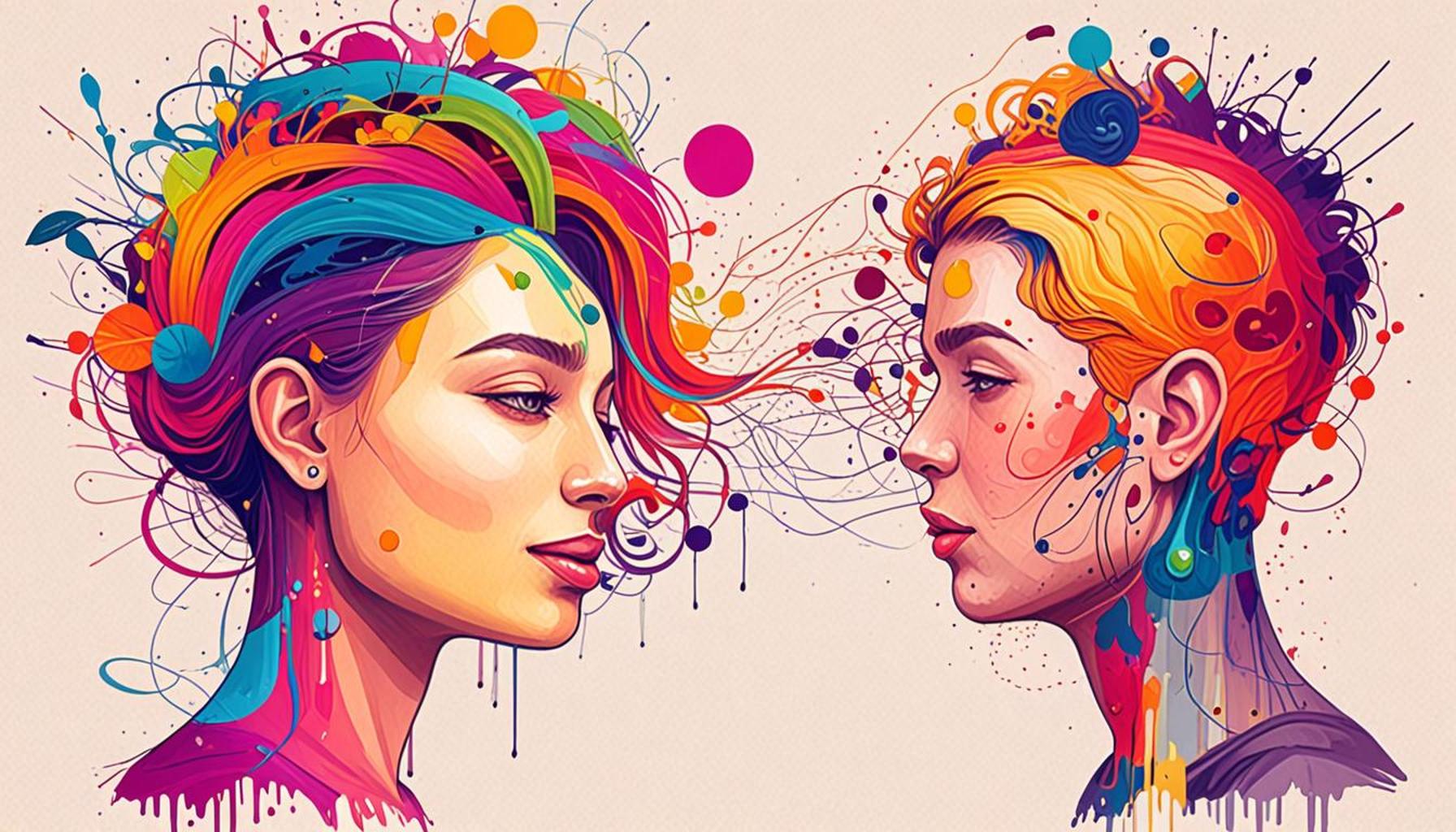The Art of Dialogue: Techniques for Creating Authentic Conversations in Your Texts

The Heartbeat of Storytelling: Engaging Through Dialogue
Dialogue is more than just the spoken word; it serves as the lifeblood of storytelling, breathing vitality into characters and moving the plot along. Authentic dialogue acts as a powerful tool in the writer’s arsenal, tapping into the underlying emotions and intentions of characters, and influencing how readers connect with the narrative.
Well-crafted dialogue not only enhances a story but also serves multiple functions. For instance, effective speech can:
- Reveal character intentions and emotions: Through words and tone, characters can express conflicting feelings—fear, desire, or anger—leading to deeper engagement. A fleeting phrase, like “I’m fine,” delivered with a sigh, can unveil layers of emotional complexity.
- Create tension and drive the narrative forward: Conversations that include conflict, misunderstandings, or stark contrasts propel the plot. Imagine a scene where two friends debate critical life choices; the tension can create suspense, making the reader eager to know the outcome.
- Reflect cultural nuances and regional dialects: Local idioms and phrases provide authenticity. A dialogue sprinkled with expressions unique to Nigeria—like “My guy, na so e be” or “Omo na you go sabi” —gives the conversation vibrancy and relatability, drawing readers into the cultural landscape.
In Nigeria, where over 500 languages are spoken, the potential to weave cultural backgrounds into dialogue is immense. Writers can harness indigenous languages like Yoruba and Igbo to enhance character depth and strengthen relatability. This not only fosters a connection with local readers but also educates an international audience about the rich tapestry of Nigeria’s linguistic diversity.
To truly master the art of dialogue, aspiring writers should adopt various techniques aimed at enhancing authenticity. Effective strategies include:
- Listening to real conversations for inspiration: Observing how people interact in everyday life—be it in markets, street corners, or at social gatherings—provides invaluable insights into natural speech patterns and rhythm.
- Balancing exposition with natural speech patterns: It’s crucial to ensure that the dialogue flows smoothly and does not sound overly scripted. This requires mastering the skill of weaving backstory into conversation, allowing characters to naturally reveal their histories.
- Understanding the emotional stakes behind each line: Every dialogue should have purpose and depth. Writers must ask themselves what each character hopes to achieve and how their motives shape the conversation.
By exploring these techniques, writers can create dialogue that not only resonates with readers but also elevates their storytelling. Join us as we delve further into the intricacies of the art of dialogue, unlocking the potential for powerful and relatable storytelling that captivates audiences from all walks of life.

CHECK OUT: Click here to explore more
Unlocking Authenticity: Strategies for Crafting Realistic Dialogue
Creating authentic dialogue is a nuanced art that demands a keen understanding of human interaction. To elevate the quality of conversations within your texts, you must embark on a journey of observation and reflection. The first step in this process is grasping the essence of character personality and background, which directly influences how they articulate their thoughts and feelings.
Characters are reflections of their environments, societal norms, and personal experiences. Therefore, dialogue should encapsulate these layers to truly resonate with readers. One effective method for achieving this is through the use of distinct voice and tone. Each character in your narrative should possess a unique manner of speaking, whether it’s the sophisticated dialogue of a university professor or the colloquial expressions of a street vendor. This diversity not only enriches the narrative but paints a vibrant picture of the world you are creating.
Techniques for Creating Unique Character Voices
To develop this distinctive voice, consider employing a range of techniques:
- Character Background Exploration: Delve deep into your characters’ backgrounds. Understand their upbringing, education, and social circles. A character raised in Lagos might employ urban slang, while one from a rural area might favor proverbs and traditional expressions.
- Specificity in Language: Use specific vocabulary that aligns with the character’s profession or interests. For instance, a mechanic might throw in jargon like “cylinder head” or “spark plug,” infusing authenticity into their dialogue.
- Regional Influence: Incorporating local dialects or idiomatic expressions can help to ground your characters in their cultural context. Phrases common in Yoruba, Igbo, or Hausa can add richness while making your dialogue relatable.
Furthermore, dialogue should echo the natural ebb and flow of real conversations. Real people often interrupt each other, repeat themselves, or trail off. Mimicking these behaviors can add layers to your dialogue, making it feel organic. For example, in a heated exchange, one character might interrupt another with a fervent “But wait!” followed by a brief silence, creating an atmosphere of tension and urgency. Painting scenes with these realistic details invites readers to feel the emotions and stakes at play.
Harnessing Subtext: More Than Meets the Ear
Another cornerstone of authentic dialogue is the concept of subtext. What characters choose not to say often carries as much weight as their spoken words. The unsaid can reflect fear, uncertainty, or hidden agendas, adding depth to the narrative. For instance, a character stating, “It’s alright,” with a tone of disappointment can reveal dissatisfaction underlying their externally calm demeanor. This complexity can intrigue readers, drawing them into the psychological landscape of your story.
By combining unique voice, authenticity to character backgrounds, and the power of subtext, writers can create a dialogue that feels genuine and engaging. As we venture deeper into the art of dialogue, the exploration of pacing, conflict, and emotional stakes promises to unlock even greater potential for writers eager to captivate their audience.
In engaging narratives, the art of dialogue transcends mere conversations; it becomes a vehicle for deepening character development, enhancing plot dynamics, and drawing readers into the emotional landscape of the story. Authentic dialogue should reflect the characters’ unique voices, ensuring that each line resonates with their personality, background, and emotional state. Employing techniques such as subtext, where the underlying meaning is more significant than the spoken words, can create tension and intrigue, inviting readers to read between the lines.Moreover, the use of interruptions can mirror real-life conversations, making the dialogue more relatable. Characters may jump in and out of thoughts, leading to a flow that mimics human interaction. This technique fosters authenticity and offers a glimpse into their relationships, allowing readers to experience the nuances of conflict and camaraderie. Using regional dialects and colloquialisms can also add layers to dialogue, grounding characters in their cultural contexts and further enriching the narrative.Another essential aspect to consider is the pacing of dialogue. Varying the rhythm can heighten suspense or convey emotional turmoil. Short, snappy exchanges can fuel tension, while longer, reflective dialogues might provide introspection. Balancing these pacing techniques can keep readers engaged and elevate the storytelling experience.Lastly, integrating silence or pauses can be just as powerful as spoken words. It allows characters to process emotions, creating a moment of reflection that resonates with the audience. In essence, mastering the art of dialogue involves a delicate balance of voice, pace, and emotional depth, ultimately leading to rich and multifaceted conversations that linger in the minds of readers.To visualize these concepts, consider the following table that breaks down essential techniques for authentic dialogue creation.
| Technique | Description & Benefits |
|---|---|
| Subtext | Creates tension by implying meanings that aren’t directly stated, deepening reader engagement. |
| Interruptions | Mimics real-life conversation, revealing relationships and character dynamics. |
| Pacing | Varies dialogue speed to enhance suspense or reflection, maintaining reader interest. |
| Silence | Powerful pauses convey emotions and add depth to conversations. |
LEARN MORE: This related article may interest you
Enhancing Dialogue with Timing and Emotional Impact
While voice and subtext are critical components of authentic dialogue, another key element lies in the timing and pacing of conversations. The rhythm of dialogue can affect its emotional weight and the engagement level of readers. Skilled writers understand that the placement of pauses, interruptions, and the structure of exchanges can manipulate the intensity of a scene, guiding the audience’s emotional journey.
In dynamic discussions, timing can convey urgency or tension. For example, during a conflict, rapid-fire exchanges can quicken the pace and heighten intensity. This technique is particularly effective in scenes that deal with high-stakes drama, where emotions run high. Conversely, in moments of introspection or vulnerability, longer pauses can create space for reflection. Imagine a character hesitating before confessing a secret, the silence amplifying the emotional stakes. This deliberate manipulation of pace invites the audience to feel the weight of the moment.
Building Conflict Through Dialogue
Another powerful strategy for crafting authentic dialogue is weaving in layers of conflict. Conflict is not reserved for physical confrontations; it often manifests in conversations. When characters disagree or have competing desires, their dialogues can become a battlefield of words. Incorporating this element can make your narratives more engaging and realistic as characters navigate their relationships and differing perspectives.
Consider a scenario where two friends from different socio-economic backgrounds discuss money management. One might advocate for saving every penny, while the other, living in a privileged environment, embraces a more carefree attitude towards expenditure. As their exchange unfolds, the dialogue not only reveals their personalities and backgrounds but also creates tension and an opportunity for growth or resolution between them. This rendering of conflict reflects authentic human experiences, making the conversation relatable for readers.
Emotional Resonance and Honesty
Equally important is the emotional honesty present in dialogue. Characters should express feelings genuine to their experiences, which allows readers to connect on a deeper level. This emotional resonance can come through vivid descriptions of emotions before and after conversational exchanges; for instance, capturing a character’s heart racing when confronting a past lover, or feeling a knot in their stomach during a confrontation. These emotional indicators ground the dialogue, making the characters’ experiences more palpable.
Authentic dialogue should also mirror the randomness of everyday conversations. Consider how people frequently mix humor, irony, or even small talk into serious discussions. For instance, during an important family gathering, one character might crack a joke to alleviate tensions over a sensitive topic, showcasing authenticity by reflecting how individuals attempt to cope with discomfort. This blend of humor with serious undertones can enhance relatability and depth in character interactions.
The Influence of Cultural Nuances
In Nigeria, cultural nuances play a significant role in shaping dialogue. Situational contexts, such as cultural celebrations or traditional gatherings, often dictate the way characters express themselves. Incorporating local proverbs, storytelling techniques, or community references can enrich the dialogue, making it resonate more deeply with Nigerian audiences. For instance, a character engaging in a discussion about challenges could utilize the proverb, “The child who does not know how to cry goes hungry,” to convey wisdom. Such elements not only honor the cultural heritage but also invite readers to reflect on their realities.
By infusing timing, emotional honesty, conflict, and cultural richness into your dialogue, you craft conversations that capture the essence of authentic human interaction, enthralling readers and encouraging them to journey alongside your characters.
YOU MAY ALSO LIKE: Read read another article
Conclusion: Mastering the Craft of Authentic Dialogue
In the realm of storytelling, the art of dialogue serves as a vital bridge connecting characters with readers, transforming mere text into a vivid experience of human emotion and interaction. As we have explored, achieving authenticity in dialogue involves a complex interplay of timing, emotional depth, conflict, and unique cultural nuances. By skillfully manipulating pacing, writers can evoke urgency or introspection, drawing readers closer to the characters’ emotional landscapes.
The inclusion of conflict within conversations not only enhances realism but also mirrors the complexities of human relationships, fostering relatability among diverse audiences. This becomes particularly significant in the Nigerian context, where cultural specifics can enrich dialogues, making them resonate deeply with local readers. Incorporating familiar proverbs, colloquialisms, or references to cultural events can create a sense of community and authenticity, establishing a meaningful connection between the characters and the audience.
Ultimately, writers are invited to embrace the multitude of techniques available for crafting dialogue that truly reflects the intricacies of real-life interactions. By prioritizing emotional honesty, utilizing humor, and honoring context, authors can create conversations that linger in the minds of readers long after the last page is turned. As you embark on your writing journey, remember that effective dialogue is not simply a means to convey information; it is a vital tool that breathes life into your characters and brings them closer to your audience. Engage with this profound aspect of storytelling, and unlock the potential for authentic, impactful narratives.



